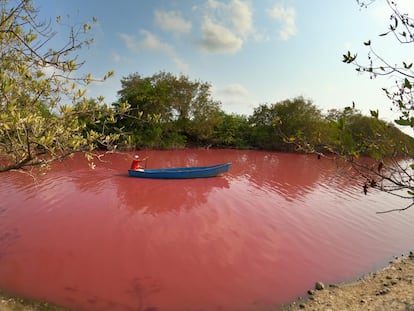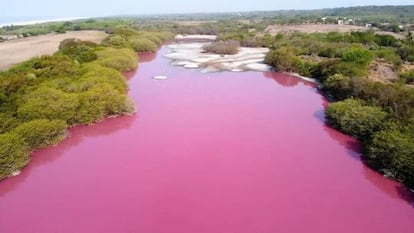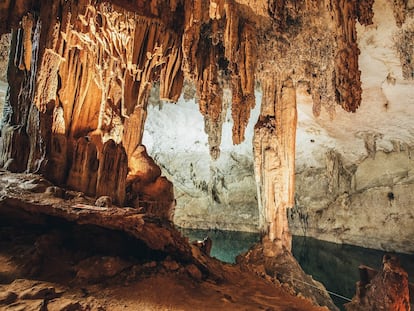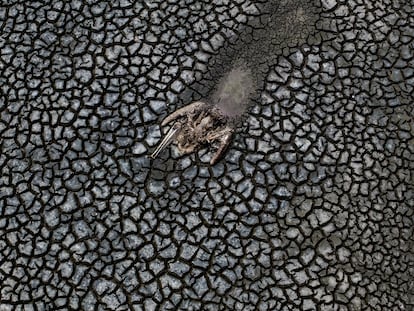Mexico’s pink lagoon: The ecological danger lurking behind the tourist attraction
Scientists say that a lack of rain and high temperatures have increased the salinity of the water, which affects the lake fauna and produces bacteria that create the striking color


Strange things began to happen a few years ago in La Escobilla lagoon, on the Mexican coast of Oaxaca. Stupefied snook and snappers swam around disoriented, and the locals could just stick their hands in the water to catch them. Then bloated mojarras and popoyotes (also known as the Chiapas killifish) began to wash up on shore smelling strongly of sulfur.
The biggest shock was yet to come. In early May, everyone who came to the lagoon did a double-take: the water had turned pink. Hericel Ramírez, a 28-year-old guide, went for his daily morning run and then headed to the lagoon, a 40-hectare (100 acres) stretch of water separated from the sea by a sand barrier. He got there and was stunned by what he saw. “Oh no! Why is it like this?” He couldn’t believe it. Ramírez, who works at a nearby sea turtle sanctuary, timidly stuck his hand in the water and noticed that it was warmer than normal. He decided not to taste it, thinking that maybe someone had spilled a toxic substance in the water. “The lagoon had never turned pink before. I took videos to send to some specialists,” he tells EL PAÍS by phone.
Biologists and students from the University of the Sea (Universidad del Mar - UMAR) in the Oaxacan city of Puerto Escondido rushed to La Escobilla, a community of two dozen houses scattered between the road and the waves. They took water samples for laboratory analysis and quickly ruled out a toxic spill. The researchers believe that persistent drought and lack of rain have stimulated the production of pink pigments by bacteria and microalgae in the water.

The phenomenon is well known. La Escobilla is the third coastal lagoon in the state of Oaxaca to turn pink in the last six years. In 2016, it happened in Coyula, which is part of a protected wetland area, and also in 2019, in Manialtepec. The first time it happened, locals muttered about biblical plagues, and biologist Eugenio Villanueva, a member of the Huatulco Clean Beaches Committee, had to come and provide a scientific explanation. “We told everyone that while it may look pretty, it’s really a sign of pollution and ecological stress,” he explains. “But it’s still a shock when it happens, even though those of us that work in environmental science immediately recognized the cause.”
The underlying problem is drought. The rainy season is now shorter, and rainfall is more infrequent. Some of the rivers that feed the coastal lagoons have become seasonal waterways, or have dried up altogether. The entire Oaxacan coast is yellow on the Mexican government’s drought maps, designating it as “abnormally dry.” Only the Yucatan peninsula, Tabasco, and some small pockets of Mexico are not in a drought.
Hericel Ramírez says that La Escobilla lagoon was 10 meters deep during his father’s lifetime. Now, it’s usually only a meter and a half deep, and gets up to five meters during the rainy season. “We’ve had very little rain for the last five years. It might rain for three days, and then nothing for the next month and a half,” says Ramírez. The mouth of the lagoon doesn’t open into the sea anymore since its water level is so low in the fall, so the lagoon water is never replenished.
Compounding the problems produced by the lack of precipitation are high temperatures that cause more evaporation and increase salinity. “The outflow of water by evaporation is greater than the inflow from rivers and the sea,” says biologist Nieves Trujillo, who teaches at UMAR and has studied the phenomenon since it first appeared in 2016. “This increases salinity to around 45 units, which is very high. Normal salinity for an ocean is 30 units.”
As salinity increases, the microalgae in the lagoon activate a kind of defense mechanism that produces an orange pigment. Over time, the microalgae are displaced by halophilic bacteria that like the high salt concentration, and these produce a red pigment. Under extreme conditions such as those at La Escobilla, the entire lagoon is permeated by the red pigment, which looks pink on the surface. “Salt concentration and light intensity cause these microorganisms to become stressed and react this way,” explains Trujillo.

The fish in the lagoon die due to the low oxygen levels of the water, also caused by high salinity. The crocodiles simply change their diet – instead of fish, they eat carrion. However, storks and roseate spoonbills no longer flock to the lagoon because there is nothing left to feed on. Local fishermen now have to go out into the open ocean to fish. “The lagoon used to feed the community, but there has been no fishing for two years. The few fish that remained have all been caught and the rest died,” says Hericel Ramírez.
The tourism boom in this area of Oaxaca, invigorated by two international airports within 100 kilometers (62 miles), is requiring more and more resources. The highway that runs along the coast and past La Escobilla is being widened, another obstacle for the rivers that carry freshwater to the coastal lagoons. People that live along the tributary streams are extracting sand and gravel to use in construction. “The systems are degrading at a high rate,” says Villanueva. “To restore the lagoon, it would have to be dredged, and the freshwater streams that feed the lagoon would have to be cleaned up.”
However, the two root causes of the problem – lack of rain and temperature increases – are beyond the capabilities of any well-meaning biologist. Like Coyula, the La Escobilla lagoon also runs the risk of drying up completely. “I wish we could open up the hydrant and replenish the lagoon with seawater,” says Trujillo. “If we have another year of drought, these types of phenomena are going to last longer or become permanent.”
Meanwhile, the community of La Escobilla is determined to make the best of a bad situation. The lagoon has run out of fish, but its bright pink color has attracted local and international tourists. Word has spread and they are coming to see if what they read on social media is true. And, of course, to take pictures, despite scientists’ warnings that the striking color is a sign that something is wrong in the ecosystem. To take advantage of this sudden interest, the town’s festival committee has begun to control access to the lagoon and ask for voluntary contributions from visitors. It is not yet sea turtle nesting season – a big tourist attraction for the town – and the pink lagoon can provide an additional source of income.
No one knows how long this will all last. Biologists say that the color will fade when the rains start. A brief shower fell on the lagoon recently, but it’s still bright pink. The community is praying that it will last a little longer. Just in case, Hericel Ramírez walks to the lagoon every morning to make sure. “If it goes back to the way it was, it won’t be a tourist attraction anymore, and there’s not a single edible fish left to catch,” he says. “The only thing to do is make the most of the tourists.”
Tu suscripción se está usando en otro dispositivo
¿Quieres añadir otro usuario a tu suscripción?
Si continúas leyendo en este dispositivo, no se podrá leer en el otro.
FlechaTu suscripción se está usando en otro dispositivo y solo puedes acceder a EL PAÍS desde un dispositivo a la vez.
Si quieres compartir tu cuenta, cambia tu suscripción a la modalidad Premium, así podrás añadir otro usuario. Cada uno accederá con su propia cuenta de email, lo que os permitirá personalizar vuestra experiencia en EL PAÍS.
¿Tienes una suscripción de empresa? Accede aquí para contratar más cuentas.
En el caso de no saber quién está usando tu cuenta, te recomendamos cambiar tu contraseña aquí.
Si decides continuar compartiendo tu cuenta, este mensaje se mostrará en tu dispositivo y en el de la otra persona que está usando tu cuenta de forma indefinida, afectando a tu experiencia de lectura. Puedes consultar aquí los términos y condiciones de la suscripción digital.
More information
Últimas noticias
Trump claims peace in Ukraine is near, but Moscow suggests otherwise
A survivor’s account of the Interoceanic Train accident: ‘We were scared because of the speed on the curve’
The Interoceanic Train, the Mexican alternative to the Panama Canal
What is known about the Interoceanic Train derailment in Oaxaca
Most viewed
- Oona Chaplin: ‘I told James Cameron that I was living in a treehouse and starting a permaculture project with a friend’
- Reinhard Genzel, Nobel laureate in physics: ‘One-minute videos will never give you the truth’
- Why the price of coffee has skyrocketed: from Brazilian plantations to specialty coffee houses
- Pablo Escobar’s hippos: A serious environmental problem, 40 years on
- Chevy Chase, the beloved comedian who was a monster off camera: ‘Not everyone hated him, just the people who’ve worked with him’










































